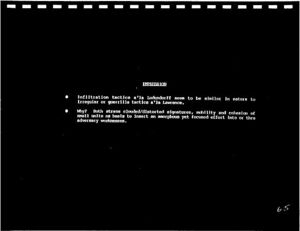Patterns of Conflict
| The works of |
| Works of John Boyd |
|---|
OODA WIKI Edition
Quantico Transcription
The infiltration tactics a la— seem to be, at least out in the field—
Now we’ve got to be careful, because we’re going to get into some other aspects of guerrilla war that are quite different. But out in the field, the infiltration tactics, a la Ludendorff, are very similar to the guerrilla tactics as seen through Lawrence’s eyes, very similar.
And why? Very simple. Because they both define the same kind of a game. The important thing is with the advent of modern weapons, rather than the guerrillas gravitating toward the regular force’s techniques, the regular forces did what, gravitated to the guerrilla techniques because of the lethality of modern weapons. That’s exactly right. At least in the field, I’m talking about. Some of those things we got to touch on here.
So we’ll begin to see those kinds of things begin to emerge. And see, as I mentioned before, even in World War I they didn’t like to do it, because they still hadn’t come to grips with night attacks. Nobody likes to make night attacks. Why don’t people like to make night attacks?
And Clausewitz said oh, a night attack, you read Clausewitz, oh, that’s a disaster. He’s full of baloney. Because he looked at an absolute sense. And the reason why, it’s very confusing. Well, guess what? It’s confusing for the other side too.
And as I said last night, Terry Allen,[1] an infantry general in the Army in World War II, he trained his people at night, and they slept during the daytime. The Pentagon was furious at him. He said well, we had a duty officer in the daytime. He said you want to call me, call me at night.
And he was the most successful division commander, infantry division commander, over in Europe, first time in North Africa. But he always went off at night. And they said well, Christ, that’s confusing. He said yeah, but the other guy’s more confused, because we’ve been training and they haven't.
And that’s the issue. You’re going to be confused. Can you get him more confused? That’s the name of the game. As long as he’s more confused, you got the leverage. You’ve got the initiative. You’re pulling his pants down. He’s not pulling yours down. Damn right it’s confusing. But if you are acclimating yourself to it, doing it over, and your guy’s, Christ, it’s kind of natural in this confusion. The other guy hasn’t been doing it. You’re gaining leverage.
Okay? I might add he was fired, Allen. And the reason why— he got his job back later on. He was fired after North Africa because his troops got out of hand. He gave them a lot of liberties, and Eisenhower got mad at him and canned him, sent him back to the States. And then they gave him the worst misfits in the army to put together another division, and he did. And then after— it wasn’t right away after Normandy, but he went back to Europe. And again, he was the best division commander with a brand new outfit. Same thing, attacking at night.
He thought that other way was rather unattractive. Why do I have to lose my whole division, or half my division, for making a goddamn daylight attack? This is bullshit. I’m going to do it different. And the name of the game, we like to get out of the— not only take our objective, but we’d like to have a lot of guys standing at the end. That’s not a bad idea. I think it’s rather attractive. I think his troops felt it was rather attractive, too. They loved him, naturally.
Lightfoot Transcription
- ↑ In World War II, General Terry Allen commanded the 1st Infantry Division during North Africa and Sicily campaigns, and later commanded the 104th Infantry Division during operations in France, the Netherlands, and Germany. While Boyd states that General Eisenhower relieved Allen of command of the 1st Infantry Division, this occurred at the recommendation of General Omar Bradley, whose personality often clashed with Allen’s, and who believed Allen did not instill sufficient military discipline in his soldiers.
